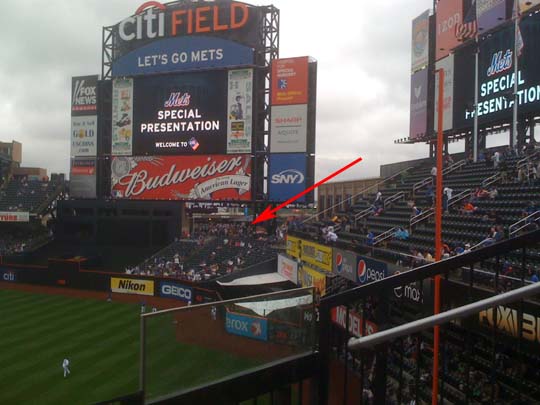
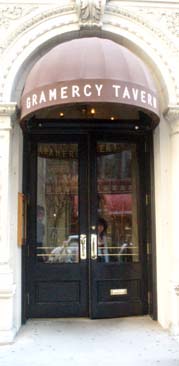
Note: Click here for a more recent review of Gramercy Tavern.
It’s hard to be both good and popular. Large restaurants with mass appeal can’t risk challenging their customers with unusual recipes, ingredients that are hard to pronounce, or menus that stray far from the old standards.
These realities are evident at Gramercy Tavern, which has practically defined New American haute barnyard cuisine since its debut in 1994. It was the first restaurant as co-owner for chef Tom Colicchio, who had worked his way through several three and four-star kitchens; and the second restaurant for Danny Meyer (after another huge hit, Union Square Cafe).
 The list of chefs who have cooked in Gramercy Tavern’s kitchen reads like a who’s who of New York dining: Marco Canora and Paul Grieco (both now at Hearth, Insieme and Terroir); Jonathan Benno (now chef de cuisine at Per Se); Damon Wise (now executive chef at Craft); pastry chef Claudia Fleming (now co-owner at North Fork Table & Inn); John A. Schaefer (now chef–partner at Irving Mill).
The list of chefs who have cooked in Gramercy Tavern’s kitchen reads like a who’s who of New York dining: Marco Canora and Paul Grieco (both now at Hearth, Insieme and Terroir); Jonathan Benno (now chef de cuisine at Per Se); Damon Wise (now executive chef at Craft); pastry chef Claudia Fleming (now co-owner at North Fork Table & Inn); John A. Schaefer (now chef–partner at Irving Mill).
Before they opened, Meyer and Colicchio rather foolishly said that they were out to “reinvent the four-star restaurant.” Then, as now, if you say you’re gunning for N stars, it’s a sure bet you’ll get at most N–1 . That’s exactly what happened, as Ruth Reichl awarded an enthusiastic three stars in the Times. But as Colicchio drifted away, the restaurant ran on auto-pilot.
Two years ago, Meyer and Colicchio had an amicable divorce. Colicchio wanted to focus on his Craft empire, and Meyer wanted a full-time chef. To replace Colicchio, Meyer hired Michael Anthony, formerly Dan Barber’s partner at the Blue Hill restaurants—places that borrowed a lot from Gramercy’s haute barnyard ethos, and arguably improved upon it.
The current Times critic, Frank Bruni, had “a few forgettable dinners” and “a clumsy, laughable one” during the first few years of his tenure. Unusually for him, he gave Anthony time to right the ship before weighing in with a respectful three-star re-review last June. Bruni was about right, when he noted:
There are restaurants with more shimmer, and there are certainly restaurants with more spark. There are restaurants that take bigger chances and stake bolder claims to your attention.
But is there a restaurant in this city more beloved than Gramercy Tavern?
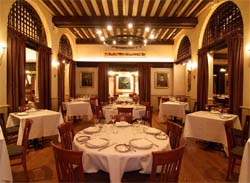 It was a tough to get a table here in 1994, and it is tough today. In the Zagat survey, Gramercy Tavern is the second-most popular restaurant in New York (behind only Union Square Cafe). Its Zagat food and service ratings are 27 out of 30; no restaurant is higher than 28 in either category
It was a tough to get a table here in 1994, and it is tough today. In the Zagat survey, Gramercy Tavern is the second-most popular restaurant in New York (behind only Union Square Cafe). Its Zagat food and service ratings are 27 out of 30; no restaurant is higher than 28 in either category
When reservations opened for Valentine’s Day, they sold out in something like fifteen minutes. Even on a “normal” day, Gramercy Tavern is usually booked solid at prime times. To be sure of getting a table, you need to call four weeks in advance at 10:00 a.m., wait on hold, and cross your fingers. By the time you get through you may find that 5:30 and 10:00 are the only times remaining. We were finally able to book on OpenTable during the slower summer season.
 Gramercy is really two restaurants in one, with a casual no-reservations “tavern room,” which serves an à la carte menu; and the more upscale (but not really formal) dining room, where your only choices for dinner are an $82 three-course prix fixe, which we had, or one of two tasting menus ($88; $110).
Gramercy is really two restaurants in one, with a casual no-reservations “tavern room,” which serves an à la carte menu; and the more upscale (but not really formal) dining room, where your only choices for dinner are an $82 three-course prix fixe, which we had, or one of two tasting menus ($88; $110).
Like all of Danny Meyer’s restaurants, Gramercy Tavern practically defines excellent service. I was seated immediately, even though my girlfriend had not yet arrived; and they gave us as long as we wished to ponder the menus. There was no sense of being rushed through the meal, even though you can bet your life that our table was going to be turned. Our three-course dinner played out over a relatively leisurely two hours and forty minutes.
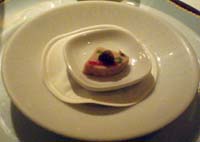 The wine list is of middling length, but there is something on it for just about everybody. I was pleased to find a 1996 Fronsac for $72, an unusually low price for a decently aged French wine. It was a bit tight at first, but opened up nicely over the course of the evening.
The wine list is of middling length, but there is something on it for just about everybody. I was pleased to find a 1996 Fronsac for $72, an unusually low price for a decently aged French wine. It was a bit tight at first, but opened up nicely over the course of the evening.
The amuse-bouche (photo right) was a small wedge of house-made sausage. There were three kinds of bread to choose from, but none of them really floated my boat. The olive bread was too hard, and the butter wasn’t soft enough.
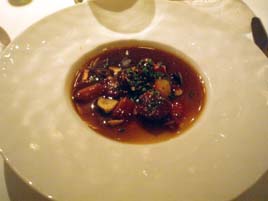

Foie Gras Custard with cherry marmelade and hazelnuts (above left) was probably the most exciting dish we tasted. Besides being very good in its own right, it was a more creative way of presenting foie than the usual terrine or torchon.
But Lamb Pappardelle (above right) was cliché, other than the unusual beet greens on which it lay, and it wasn’t quite warm enough. It wasn’t a very attractive plating, either.


Neither entrée offered a trace of originality. Glazed Duck Breast and Duck Leg Confit (above left) were at least impeccably prepared. The duck skin was crisp, the inside succulent and tender. We were less enchanted with Rack of Pork and Braised Belly (above right). The rack was slightly on the tough side, while the belly didn’t have quite the crisp–gooey texture that it should.
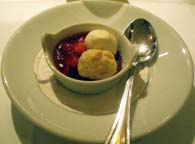



If, like the rest of the meal, the sweets were devoid of fanfare, they were all at least well executed. The palate cleanser (top left) was a strawberry–rhubarb crisp. I had the selection of cheeses (top right), while my girlfriend had the Grand Marnier Mascarpone Cheesecake (bottom left), which she felt the average chef could make at home. I found nothing wrong with it, though. The meal concluded with petits-fours (bottom right).
I agree with Frank Bruni that the empire’s best food in Danny Meyer’s burgeoning restaurant empire is now being served at Eleven Madison Park and The Modern. (Bruni favors the latter’s bar room over its formal dining room, but at least he has the right address.) Gramercy Park has become the Zagat set’s go-to occasion place. There’s no doubt that Michael Anthony is a serious chef, and unlike Tom Colicchio he’s actually here most of the time. But the menu falls back on predictability, which doesn’t leave much room to excuse its occasional flubs.
You won’t have a bad meal at Gramercy Tavern—far from it—but there’s more excitement to be had elsewhere.
Gramercy Tavern (42 E. 20th Street between Park Avenue South & Broadway, Flatiron District)
Food: **
Service: ***
Ambiance: **½
Overall: **½
 Tuesday, December 15, 2009 at 05:08PM
Tuesday, December 15, 2009 at 05:08PM 








